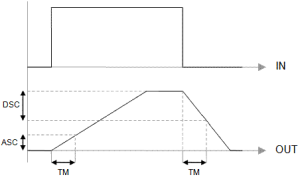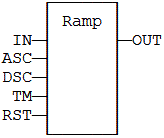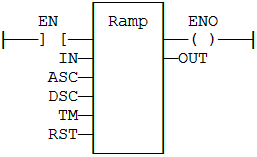![]()
 Function
Function![]() A function calculates a result according to the current value of its inputs. A function has no internal data and is not linked to declared instances. - Limit the ascendance or descendance of a signal.
A function calculates a result according to the current value of its inputs. A function has no internal data and is not linked to declared instances. - Limit the ascendance or descendance of a signal.
Inputs
|
Input |
Data Type |
Range |
Unit |
Default |
Description |
|---|---|---|---|---|---|
|
IN |
REAL |
|
|
|
Input signal. |
|
ASC |
REAL |
Maximum ascendance during time base. |
|||
|
DSC |
REAL |
Maximum descendant during time base. |
|||
|
TM |
TIME |
Time base. |
|||
|
RST |
BOOL |
Reset. |
Outputs
|
Output |
Data Type |
Range |
Unit |
Description |
|---|---|---|---|---|
|
OUT |
REAL |
|
|
Ramp signal. |
Remarks
- Parameters are not updated constantly.
- They are taken into account only when the:
- The block is called the first time.
- Reset input (RST) is TRUE.
- In these two situations, the output is set to the value of IN input.
- They are taken into account only when the:
- ASC and DSC give the maximum ascendant and descendant growth during the TB
time base.
- Both must be expressed as positive numbers.
Time Diagram
FBD Language Example
FFLD Language Example
- In the FFLD
 "Free Form Ladder Diagram" Language, the operation is executed only if the input rung (EN) is TRUE.
"Free Form Ladder Diagram" Language, the operation is executed only if the input rung (EN) is TRUE.- The output rung (ENO) keeps the same value as the input rung.
- The function is executed only if EN is TRUE.
- ENO keeps the same value as EN.
IL Language Example
(* MyRamp is a declared instance of RAMP function block *)
Op1: CAL MyRamp (IN, ASC, DSC, TM, RST)
FFLD MyBlinker.OUT
ST"Structured text" A high-level language that is block structured and syntactically resembles Pascal OUT
ST Language Example
(* MyRamp is a declared instance of RAMP function block *)
MyRamp (IN, ASC, DSC, TM, RST);
OUT := MyBlinker.OUT;









